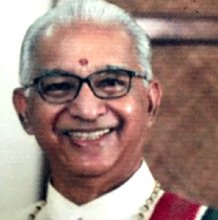Raama Raajyam - V.P. Dhananjayan e-mail: bkalanjali@gmail.com  Now that a great temple for Sri Raama - the ultimate Maryaada Purusha - has come up in His janmabhoomi Ayodhya, we can hope and pray for a Raama Rajya in the days to come. Valmiki in his aadi kaavya Raamayana eulogises the attributes of a perfect and benevolent king whose ideology is nothing beyond serving his subjects with justice and truthfulness. Judicious approach aiming for a peaceful, easeful and useful administration for absolute well being of His 'praja' or subjects. At the beginning of the kaavya itself, we are introduced to Sri Raama as, Gunavaan (blemishless character), veeryavaan (courageous & valorous), dharmagjna (righteousness personified), kritagna (dutiful), satyavaak (truth personified), dhridda vrathaha (steadfast), all such good qualities needed for a ruler of a country. Raama Naama and His story run in the veins of all Bhaarateeya around the world irrespective of any manmade religions. During ancient periods before and after Raama, there existed no religion, namely the Hindu or the term Hindu. The foundation is laid on the solid rock foundation of a life style called "Sanathana Dharma", synonymous with the term Raama Raajyam. After Valmiki Raamayana, Raam Rajya is a term that was popularised by Mahatma Gandhi. An ideal society that he envisioned for Swathantra Bhaaratam (independent Bhaarat) based on the rule of Sri Raama. The concept of Raam Raajya reflects the idea of an ideal society where everyone is equal, and justice prevails. The term represents the ideal king who ruled with wisdom, compassion, and justice. His rule was characterised by the following principles: Satyam-samathwam-swathanthryam: Mahatma Gandhi emphasised the importance of truth, equality and freedom in his concept of Raam Raajya, symbolised in the tricolour national flag - saffron for truth, white for equality and green for freedom. He believed that all individuals, regardless of their caste, creed or gender, should have equal opportunities and rights. A society practicing the ideology of "there is no religion higher than truth". During Raam Raajya, there was no religion, not even the term Hindu was mentioned anywhere. Justice: Raam Raajya was a society where justice was served, and no one was above the law. Following the tenets of Valmiki Ramayana, Gandhi emphasised the importance of self-discipline and self-sufficiency in achieving justice. He believed that individuals should work to become self-sufficient, both economically and spiritually, in order to be better equipped to address injustices in society. Ahimsa paramo dharma: Non-violence is the hallmark of Raam Raajya, a society where violence was shunned, and conflicts were resolved through peaceful means. Non-violence is the cornerstone of Gandhi's concept of Raam Raajya. He believed that violence only begets violence and that the use of force can never bring about lasting peace. Instead, he advocated the use of non-violent means such as satyagraha (civil disobedience), ahimsa (non-violence), and self-control to achieve one's goals and of course he achieved his goal obtaining freedom from the treacherous rule of invaders. Self-Rule: Raam Raajya was a society built on discipline, devotion and dedication, a system where people could engage themselves in self-governing and have the power to make decisions that affect their lives. Prosperity: Raam Raajya was a society where everyone had access to the basic necessities of life and had the opportunity to pursue their dreams. Moral and Spiritual Values: Gandhi's vision of Raam Raajya was not merely a political system but rather a society based on moral and spiritual values. He believed that society should be grounded in truth, love, compassion, and forgiveness. Individuals follow conscience to serve others, not self-interest. Decentralisation of Power: Gandhi believed that power should be decentralised and that decision-making should be made at the local level. He advocated for the establishment of Gram Sabhas, or village assemblies, where the people could come together to make decisions that affect their community. The representatives of such self-governing bodies should be absolutely blemishless, clean popular leaders with absolute selflessness. Trusteeship: Gandhi believed that Trusteeship was essential for creating an equitable and just society. He argued that wealth was not an end in itself, but a means to serve the common good. In Raam Raajya, the wealthy and powerful would act as trustees, using their resources for the betterment of the poor and the needy. Gandhi's idea of Trusteeship was based on the principle of non-violence and voluntary cooperation. He believed that the wealthy and powerful should voluntarily surrender their wealth for the betterment of society, rather than through force or coercion. Economic Equality: Gandhi believed that economic inequality was one of the root causes of social unrest. He advocated for the abolition of the caste system and the establishment of a society based on economic equality. According to Valmiki Raamayana there was no caste system but society was classified by their profession, mainly four. Brahmana (highly learned scholars & teachers), Kshatriya (administers / defence), Shudra (labourers) and Vaisya (business / traders). Self-Sufficiency: Gandhi believed that self-sufficiency was crucial for the development of society. He advocated for the establishment of rural small-scale industries and the use of local resources to promote self-sufficiency. Education: Gandhi believed that a right kind of education emphasising on good character and conduct was essential for the development of individuals and society. He emphasised the importance of holistic education, which includes both intellectual and moral development. Moral values should be inculcated in children from the formative ages for which a spiritual upbringing is essential and a necessity to lead a peaceful, easeful and useful life. Democratic system: Constitutionally, Bhaaratam adopted this modern concept of Abraham Lincoln, founder father of the United States of America (USA) and defined the system as, of the people, by the people and for the people. A perfect match to Raama Raajyam provided the elected representatives fall in line with its prescribed yardstick. A big question should be addressed to our electoral system where any Tom, Dick and Harry - irrespective of their character, conduct and qualification - could contest an election and even become ministers and hold high office. Statistics say 40 to 60 percent of MPs and MLAs have different kinds of court cases against them. Multi-party system has proved detrimental to a true democratic administration and unless and until we have blemishless representatives elected to the parliament and State assemblies, the prevailing democratic system cannot come closer to Gandhi's Raama Raajyam.  Naatyacharya V.P. Dhananjayan is the Founder/President, Bharatakalanjali, Chennai. |
